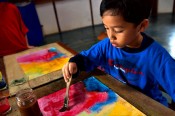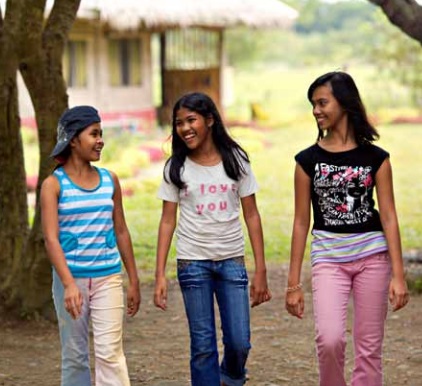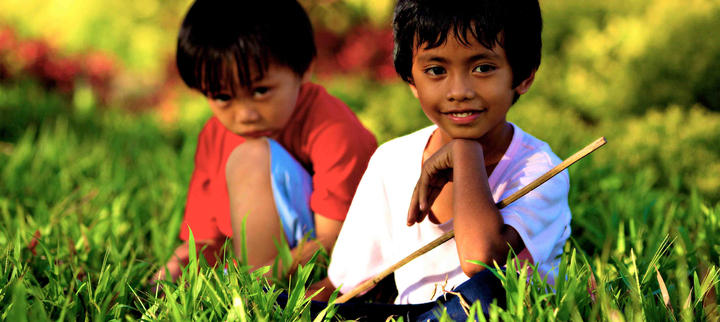Waldorf News
Gamot Cogon School: We Have a Dream

By ANNA TERESA SLATER
We knew Jamal was from a very poor family, but we didn’t know just how poor until the day he came to school with wet clothes. When his teacher inquired about his dampness, he replied that his clothes were washed the day before and didn’t have enough time to dry overnight—he had nothing else to wear.
There are many other children from economically deprived families who come to Gamot Cogon, a Waldorf-inspired school in Zarraga, Iloilo, Philippines. In fact, at least 40% of the children come from the surrounding rural villages comprised of large families living well below the poverty line. Many of the people find seasonal work as farmers, tricycle drivers or laborers earning around $50 a month and supporting an average of three to four children.
Gamot Cogon Institute (GCI) was founded in 2005 by James Sharman, Teresa Jalandoni, Nicanor Perlas and a few others interested in the ideas of Rudolf Steiner. The first project of the initiative was to setup a Steiner School which was then named Gamot Cogon School.
The school started with only four students in class three and one teacher. However, each year more and more children kept finding us so that by this school year, 2011-12, we have 150 children from Kindergarten to Class 9, with 12 full-time and three part-time teachers.
Shortly after the school opened, it also became clear that as the school was envisioned to grow, there would be a need for more and more teachers to receive training—teachers not only from Gamot Cogon School, but also those from the other Steiner/Waldorf schools in the country as well as those wanting to begin schools in other areas. Thus, the Steiner Education Teacher Training Program was founded. Every year since then, experienced teacher trainers have been flown to Iloilo from Germany and other countries to facilitate eight weeks of intensive training spread out between November, February and April.

Gamot Cogon School was originally setup to cater to the underprivileged so school fees are socialized and the families pay only what they can afford.
Interestingly, a year after the school opened, some well-to-do families from the nearby city of Iloilo started sending the children to our school. They were searching for alternative education and wanted their children to be in a stress-free, nature-filled environment.
Soon, children of poor farmers were playing, learning, and eating side-by-side with children of successful doctors and lawyers. We did not fully realize the beauty and positive social implications of such a setup until one of the parents from the city overheard a local mother tell her daughter not to play with the “rich kids.” Her daughter replied, “No mother, it’s different here. We are all the same here.”
That is when some of us knew for sure that this school was doing something truly different. In every class level, the social classes are so mixed and integrated that there is no visible segregation to be found. The son of a doctor is best friends with the daughter of a janitor. The daughter of a politician happily shares her lunch with an orphan from a village for street children. In our school we do not have to do much for the children to learn fairness, equality, acceptance or compassion. The very composition and setting of the school allow for these values to resound in the children naturally.
We, the teachers, found our way to the school because we share a common purpose. That is, to help the community and to educate children regardless of their economic background. The salary is low, the resources scarce, and the hours are long. This year, the teachers gave up their brand new teachers’ room without question so that Class 9 would have a classroom. Often, our teachers even give their own money so that some students can eat breakfast to quell a painful, empty stomach or so that a child can take a tricycle home instead of walking for 45 minutes in the oppressive heat. However, at the end of the day there is fulfillment and inner peace.
At meetings we share our golden moments about the students and we are energized and reminded about the importance of our work. One teacher emotionally shares about how his student—a girl named Rose who lives in a tiny, windowless cement house with her father—recited Martin Luther King’s “I Have a Dream” speech with such passion that the class was left breathless.
Another teacher shares how a very poor boy named Samon went up to her with P50 (US$1) and said it was his contribution to the family of a schoolmate whose father had passed away the week before. Another teacher relays how one of her students in Class 1 came to school with no lunch. When she asked her students, “Who has extra food to share with Jannia?” practically all the students jumped up to volunteer—including children who did not even have enough for themselves.
 It was four years ago when I started working for the school initially as an Administrator, and my husband, Warren, was the Class 6 teacher. Before then, we were teaching English abroad but needed a change. I also wanted to do social work in my own country and I knew that my mother had helped found this school.
It was four years ago when I started working for the school initially as an Administrator, and my husband, Warren, was the Class 6 teacher. Before then, we were teaching English abroad but needed a change. I also wanted to do social work in my own country and I knew that my mother had helped found this school.
So we quit our high-paying jobs and made that big leap from the bright lights of cosmopolitan Bangkok to the dirt roads of sleepy, Zarraga; to a school situated next to a cow pasture and surrounded by tall bamboo.
Since then, Warren and I both agree that we have never worked harder in our lives, have never been so challenged emotionally, physically, and psychologically—not to mention the 75% drop in our salaries. Yet, the shift into a less materialistic lifestyle was seamless. The work we needed to do was clear.
I now teach English in many of the classes and never run out of touching stories to tell about my experiences. One story I fondly recall is when I collected money from friends to buy jackets for some students.
It was January so the days were getting a little cooler and some of the children were getting very cold hands and feet. When the jackets were handed out, one boy was so happy to own a jacket that he wore it every day, even while playing games on a hot day. When I asked his class teacher, “Doesn’t he feel hot?” she replied, “I’m sure he does! But he can’t believe he has his own jacket and so he won’t take it off!”
These are the stories that keep us going no matter how difficult things may seem. Funding the school and keeping up with its growth have proven constant challenges, but we somehow manage to find kind souls who help out at the times we need them most. We accept fundraising as a fact of life and as a chance to offer others the possibility to also contribute. We have recently been able to offer food programs for children from families who cannot afford to send more than just rice for lunch. We have collected second-hand clothes to give to children like Jamal.
Furthermore, some privileged families pay more than needed to help cover the costs of another child’s schooling. There is still much to be done, but we are taking it one step at a time, one golden moment at a time. Because when we see students like Doris—with five siblings, living in a hut with a dirt floor and no electricity—pleading for more books about Wizards or Roman History; or children like Evon—the son of our grounds keeper—who is turning out to be quite the violinist, we need to keep taking those steps. We are being called to do it.

We believe every child has a right to holistic, high-quality education and that Steiner Education was meant to be accessible not only to a privileged few. In a country where the rich are getting richer and the poor are getting poorer, where corruption is ubiquitous, maybe one day our students will make a difference.
Maybe one day they will go out into the world and fight for equality and the eradication of poverty. We hope that what they experience in our school will one day influence the way they live their lives in whatever profession they choose—as a doctor or a farmer, as a politician or a truck driver. And we hope to inspire other initiatives to do their work with a similar outlook and goal. Then, we imagine what kind of new golden moments we will all be able to share. Like Martin Luther King, like Rose, we too have a dream.
This article originally appeared in Pacifica Journal, a biannual newsletter published by the Anthroposophical Society in Hawai’i. Gamot Cogon School: We Have a Dream appeared in the 2012, No. 41, Vol. 1 issue. For more info about Pacifica Journal and to look at past issues, visit www.anthroposophyhawaii.org.
For more information about Gamot Cogon School, visit www.gamotcogon.org/school. There is a direct link on the website for donations.
The Friends of Waldorf Education helps support the Gamot Cogon School. To learn about their work and other Waldorf projects they support around the world, click here.
Photos by Damon Lynch, www.damonlynch.net
 Apply Today: New Cohort Starts Nov. 2025
Apply Today: New Cohort Starts Nov. 2025 Resiliency and the Art of Education
Resiliency and the Art of Education Quality Education in the Heartland
Quality Education in the Heartland Association for a Healing Education
Association for a Healing Education Great books for Waldorf Teachers & Families
Great books for Waldorf Teachers & Families ~ Ensoul Your World With Color ~
~ Ensoul Your World With Color ~ Transforming Voices Worldwide
Transforming Voices Worldwide Caring for All Stages of Life
Caring for All Stages of Life Summer Programs - Culminating Class Trips
Summer Programs - Culminating Class Trips Jamie York Books, Resources, Workshops
Jamie York Books, Resources, Workshops Middle School Science With Roberto Trostli
Middle School Science With Roberto Trostli The Journey is Everything
The Journey is Everything Flexible preparation for your new grade
Flexible preparation for your new grade Waldorf-inspired Homeschool Curriculum
Waldorf-inspired Homeschool Curriculum Bay Area Teacher Training
Bay Area Teacher Training Roadmap to Literacy Books & Courses
Roadmap to Literacy Books & Courses Bringing Love to Learning for a Lifetime
Bringing Love to Learning for a Lifetime Waldorf Training in Australia
Waldorf Training in Australia Full-Time Teacher Education
Full-Time Teacher Education Everything a Teacher Needs
Everything a Teacher Needs Space speaks. Its language is movement.
Space speaks. Its language is movement. Immersive Academics and Arts
Immersive Academics and Arts Train to Teach in Seattle
Train to Teach in Seattle
 RSS Feeds
RSS Feeds